The Best Paint Stripping Heat Gun in 2024 — Buyers Guide, Review and Comparison
Stripping paint can be both tedious and time consuming — but not if you have a heat gun! These hot air machines break down the adhesive bonds in the paint, enabling you to easily remove it with a scraper. Suitable for most base materials, they’re the ultimate tool for preparing surfaces for a new coat, or to reveal the natural beauty of wood. Simple to use, even for the hot air novice, they deliver the most affordable solution for paint elimination.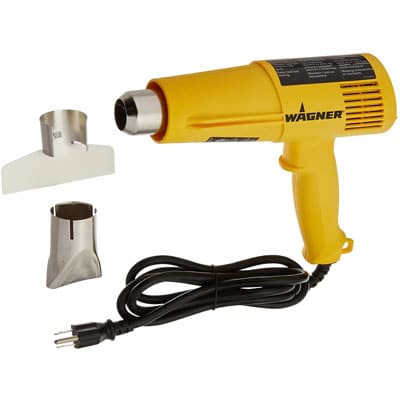
- Temperature range of 250 to 1350 degrees Fahrenheit.
- Twin fan speeds.
- Weighs two pounds.
- Low price point.
Best Paint Stripping Heat Gun Information
Top Paint Stripping Heat Guns 2024
| IMAGE | PRODUCT | DETAILS | ||
|---|---|---|---|---|
|
Best Easy Operation 
|
Best Easy Operation
|
Wagner HT3500
|
Features
|
Check Price at Amazon Wagner HT3500 Review Wagner HT3500 Review |
|
Best Top-Branded Budget 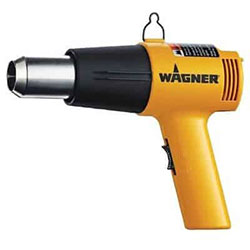
|
Best Top-Branded Budget
|
Wagner HT1000
|
Features
|
Check Price at Amazon Wagner HT1000 Review Wagner HT1000 Review |
|
Best Lightweight 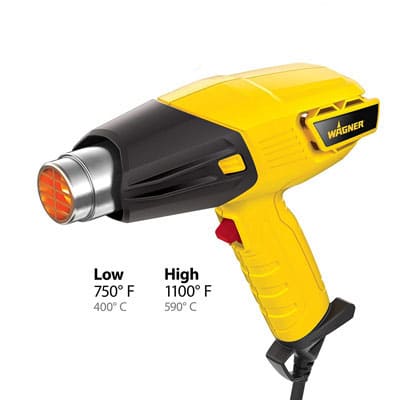
|
Best Lightweight
|
Wagner Furno 300
|
Features
|
Check Price at Amazon Wagner Furno 300 Review Wagner Furno 300 Review |
|
Best Cordless 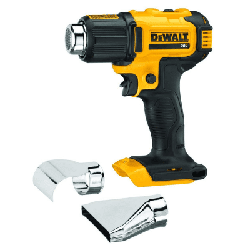
|
Best Cordless
|
DeWalt DCE530B
|
Features
|
Check Price at Amazon DeWalt DCE530B Review DeWalt DCE530B Review |
|
Best Heavy Duty 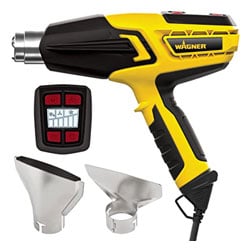
|
Best Heavy Duty
|
Wagner Furno 500
|
Features
|
Check Price at Amazon Wagner Furno 500 Review Wagner Furno 500 Review |
|
Best Temperature Range 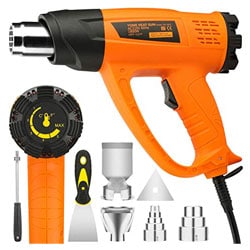
|
Best Temperature Range
|
Features
|
Check Price at Amazon Yome SDL-8622 Review Yome SDL-8622 Review | |
|
Best for Seniors 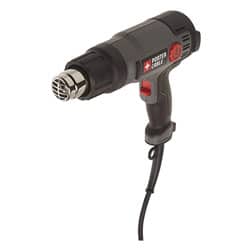
|
Best for Seniors
|
Porter Cable PC1500HG
|
Features
|
Check Price at Amazon Porter Cable PC1500HG Review Porter Cable PC1500HG Review |
|
Best for Heat Novices 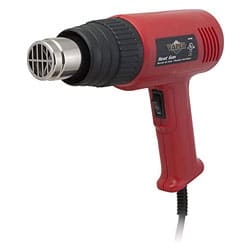
|
Best for Heat Novices
|
Titan 22400
|
Features
|
Check Price at Amazon Titan 22400 Review Titan 22400 Review |
|
Best Overall Budget 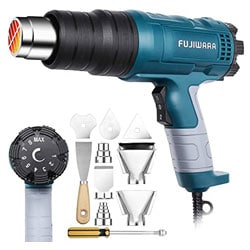
|
Best Overall Budget
|
Fujiwara 2000
|
Features
|
Check Price at Amazon Fujiwara 2000 Review Fujiwara 2000 Review |
The Best Paint Stripping Heat Gun — A Complete Buying Guide
These simple to use power tools are crucial for the decorating tradesperson or serious DIYer. They will enable you to prepare a surface for a new coat, take off layers of paint to restore hidden molded detail, or simply reveal the natural beauty of wood grain.
Furthermore, the majority of the heat guns to remove paint offer multiple temperatures. Because of this, they can also be utilized for other applications, such as thawing pipes and drying spackle. Perhaps their only restriction is that their heavy-duty nature doesn’t really make them suitable for intricate electronic work. If that’s your bag, you should check out the best hot air guns for circuit board work instead.
However, for the most effective way or peeling back years of paint — you need a paint removal heat gun.
When choosing your ideal machine, consider:
How Does Removing Paint With Heat Gun Work?
Let me tell you something — small things annoy me.
Filters on selfies, militant vegans, James Corden — they all seriously stress me out. And when it comes to hot air machines, there’s perhaps one thing that irritates me more than anything.
DIY sites declaring that heat guns burn off paint.
No, they don’t. Or if they do — you’re doing it completely wrong.
Concentrating heat onto paint agitates the polymers within. It breaks their bonds and causes the coating to bubble, blister, and lose its adhesion to the base material. This then allows you to remove the old layer(s) with a handheld paint scraper — with little to no damage to the substance beneath.
Admittedly, if you use a hot air machine on maximum, and concentrate on a single, small area — the paint will begin to burn. But this will char the wood or plastic base, which is then unsuitable for a re-coat.
For a detailed walkthrough of the correct way to remove paint with a heat gun — check out my 101 guide here.
Heat Gun Paint Remover Alternatives
Chemical Stripper
Being fluid, they’re ideal for addressing cracks and crevices, where paint resides that you cannot access with your heat gun/scraper combo. However, for large projects, such as a door, their price makes them prohibitively expensive. This is especially true if you’re tackling numerous layers — as this will require a few applications of the stripper.
You also have to be particularly safety conscious when using a chemical stripper — dependent on the variety, they can emit dangerous fumes and burn your skin.
Sanding
If you’re sanding by hand, you are looking at a long drawn-out process to make even a little headway in your project — and you’ll need a lot of stamina to keep going.
Electric sanders can make the job easier — but you have the hassles of frequent paper replacement (as it becomes clogged with paint particles). Not forgetting the requirement of periodic switching of grit grades. Furthermore, if you’re a little too aggressive with the sander, you will leave tell-tale marks on the wood. Not an ideal conclusion if you’re planning on leaving this natural grain exposed or treating it with varnish.
Some people may suggest going to the extreme of planing — but I wouldn’t recommend it. This will take off the paint, for sure, but also removes strips of wood — damaging your base material.
Infrared Removal
This is a relative newcomer to the stripping niche — aiming to take off paint at a lower temperature than that of a heat gun. Theoretically, an infrared heat paint remover penetrates through the upper layer and targets the substrate. This should break the adhesion and make the coat(s) easy to remove with a scraper.
Sounds wonderful but — in reality — it’s not so remarkable.
Firstly, they’re prohibitively expensive. You’ll struggle to find even a small handheld model for a reasonable price. Secondly, the results are disappointing. The tool appears to be fine at addressing a thin layer of paint — but anything more than a single coat and it struggles. Check out Speedheater paint remover reviews — the most popular infrared stripper brand — and you’ll see what I mean.
Benefits of Using a Heat Gun to Strip Paint
- Cost friendly — heat guns are relatively inexpensive, and require no disposable materials, not like electric sanders.
- Dust free — unlike abrasive methods of paint removal, you don’t create airborne dust.
- Safer than chemicals (well as long as you don’t do something stupid, like licking the nozzle).
- It can tackle large and small projects.
- Relatively effort-free removal — no strength required.
- Variable temperature machines can prevent damage to the base material.
- Suitable for tackling all paint types.
- You can use your gun for other jobs — such as pipe thawing or plastic molding.
How to Choose The Perfect Heat Gun for Stripping Paint
Here are the features you should consider:

Temperature Capability
At the very least, choose a gun that has a least a dual temperature capability.
A single setting machine usually delivers around 1000 degrees Fahrenheit of heat, which will undoubtedly strip paint. However, on some projects, this level of power can be counterproductive — damaging the base material beneath the coat layer.
Therefore, it’s wise to have a hot air machine that allows you to step down the power a little.
For the ultimate in control, consider a gun with numerous heat settings, such as the Wagner HT3500. These machines offer more options in the lower temperature range — which can be a bonus if you’re stripping paint from surfaces other than wood — such as plastics.

Cool-Down Mode
Despite heat guns being perhaps the most rapid method of paint removal — some projects, such as stripping banisters, are time intensive.
This exposes your unit to lengthy running times — placing its crucial heating coil under stress. While this component is built to withstand long use, it could become damaged or impaired when the unit is switched off. A rapid change from hot to cool in the coil can impair its integrity — typically occurring when the ambient room temperature is low.
Hence, some guns — for example, the Wagner Furno 500 — incorporate a cool-down feature. This allows the coil’s heat to drop off gradually — providing both immediate failure protection and extending the life of the tool. The machine will indicate when it’s cool enough to be put away for storage.

Safety Sidebars
Stripping paint with a heat gun is fun — you’re holding a pistol and shooting bullets of hot air around your home. Try making the same case for rubbing paint with a piece of sandpaper.
However, while you may feel like a futuristic Space Cowboy, at some point you need to put the gun down. Whether that’s to allow the unit to cool after use, take a gulp of coffee, or simply to adjust your working material.
The issue is, the nozzle of your hot air unit is extremely hot — put it too close to your workbench or other surface and you could be stripping paint from areas unintentionally. That’s why some models, such as the Wagner Furno 300, incorporate safety sidebars.
These useful additions allow you to lay the gun down while it’s still switched on. They prevent the nozzle from coming too close to your bench — preventing scorches, burns, and accidental fires.
Comfort
However, much of your work will be more time intensive — stripping doors or baseboards, for example. This can lead to hand fatigue or, in worse cases, carpal tunnel syndrome.
Not only can this be painful, but it will elongate the timeframe of your current job, as you need to take overly frequent breaks. Ok, I know you love wielding your heat revolver — but it cuts into valuable sports and drinking time.
Hence, always appraise how comfortable the hot air machine will be to use for extended periods.
Perhaps foremost in this consideration is weight. If you’re a gym junkie, with biceps like Ronnie Coleman, this may not be such an issue. But, if you’re like me, and the closest you get to a gym is the Taco Bell next door — it’s crucial. So, look for units that are two pounds or under, like the Wagner Furno 300, which weighs just 1.46 pounds.
Additionally, think about a machine with a padded, or at least a textured, handle. These elevate grip, which is crucial if your hands suffer from perspiration. This means that you’re not using all your forearm strength just to keep the gun in your hands.
Cord Length
The reach of the mains cable is a tricky one. Too short and you won’t be able to reach your working material from the power outlet. Too long and you could end up hanging yourself or tripping over the cord.
Hence, many manufacturers tend to take the middle ground and go for a six-foot cable. Personally, I wouldn’t opt for a unit with a shorter lead than this. Naturally, some jobs — such as stripping staircases — will require an extension cable (unless you weirdly have a power outlet halfway up the stairs). In these circumstances, always ensure you use a cord that has a suitable ampere rating for your particular heat gun.
Alternatively, you can opt for a cordless machine, such as the DeWalt DCE530B. These give you the freedom of not being tethered to the wall, with no chance of wrapping the cable around your neck. However, bear in mind that cordless machines will only provide around 40 minutes of continuous use from one charge.

Additional Nozzles
For paint stripping, additional nozzles are possibly more a luxury than a necessity.
While essential for jobs such as putty removal, desoldering, and window tinting — the standard two-inch nozzle incorporated into most heat guns is ideal for paint removal.
That said, if you’re planning on using your hot air machine for other non-stripping projects — or your paint removal is focused on intricate moldings — then consider a unit such as the Yome SDL-8622. This model comes complete with numerous nozzles.
Our Picks of the Best Heat Guns for Removing Paint
Our Rating: 4.8
In my opinion, this is the best heating gun to remove paint on the market. Versatile and with intuitive operation — this machine will suit the keen DIYer who demands accurate temperature control.
Coming from the USA-based Wagner powerhouse, this machine will grapple with a vast array of home projects — from paint stripping and drying through to bending pipes and removing decals. A simple push-button operation allows you to select the optimum temperature — displayed on an LED illuminated panel.
Also — boasting a cool-down mode and auto shut-off — accidental scorches and burns will be a thing of the past.
Features
- Choice of 750 or 1000 degrees Fahrenheit.
- Easy for the novice to grasp.
- Wallet-friendly price from a respected
- manufacturer.
- Hands-free operation.
- Design
- Functionality
- Price
At a lightweight 1.55 pounds, this unit should be a fatigue-buster — even on longer decorative projects. Alternating between the two temperature levels is effortless — just flick the handle-mounted rocker switch. And, when you require two free hands — this hot air gun includes an in-built stand.
Admittedly, it lacks the features and versatility for the professional tradesman or ardent DIY paint-removing nut. But, this robust corrosion-resistant unit could prove a valuable addition to the home toolbox.
Features
- Choice of 750 or 1000 degrees Fahrenheit.
- Easy for the novice to grasp.
- Wallet-friendly price from a respected manufacturer.
- Hands-free operation.
- Design
- Functionality
- Price
Our Rating: 4.7
Affordable, easy to use, and suitable for anything from stripping paint to lighting your grill — this dual temperature heat gun is ideal for the general householder and DIYer.
With an ergonomically-designed handle and weighing just 1.46 pounds, it prevents hand fatigue, allowing you to complete larger jobs with ease. For those projects that require two hands, such as bending and molding plastic pipes, this unit boasts a hands-free feature.
Additionally, side-mounted safety fins prevent the nozzle from touching your workbench or table when laid flat — meaning no unwanted scorches or burns to the furniture.
Features
- 1200 watts.
- Hands-free operation.
- One of the best removing paint heat guns that’s lightweight.
- Ergonomically designed to reduce hand fatigue.
- Temperature range of 750 to 1100 degrees Fahrenheit.
- Design
- Functionality
- Price
Our Rating: 4.7
Powered by a 20-volt power pack — this heat gun elevates your freedom and releases you from the constraints of a power cable.
Providing a dual temperature of either 500 or 990 degrees Fahrenheit, this machine will strip paint, desolder, and heat shrink wire casings. With an LED light, it’s ideal for use in low-light conditions, such as engine bays, beneath floorboards, and in cupboards.
A handy trigger lock enables you to use this tool hands free, while a choice of two additional nozzles provides suitable heat intensity, depending on your working material. Furthermore, a compact snub head allows this heat gun to fit into the most confined of spaces.
Features
- Choice of 500 or 990 degrees Fahrenheit.
- Allows for 42 minutes of continuous use on a single charge.
- The best heat gun for removing paint that’s battery powered.
- Modern aesthetic.
- Provides 6.7 CFM.
- Lock-off trigger.
- Design
- Functionality
- Price
Our Rating: 4.5
With an LED backlit graphic control console, this heat gun offers a novel take on information display that may suit those challenged in the visual department.
A cool-down mode should increase the longevity of the ceramic heating coil, while its soft-grip handle helps prevent hand fatigue on heavy-duty projects.
The machine delivers twelve temperature settings, from 150 to 1200 degrees Fahrenheit. This makes it suitable for thawing pipes, refreshing faded plastic, and stripping paint.
Complete with two additional nozzles and twin fan speeds, this heat gun should provide sufficient versatility for the most demanding of DIYers.
Features
- 1500 watts.
- Temperature range of 150 to 1200 degrees Fahrenheit.
- Protective sidebars.
- Hands-free use.
- Design
- Functionality
- Price
Our Rating: 4.3
Suitable for single or dual-handed operation, this tool knocks out 140-1112 degrees Fahrenheit of heat — backed up by a manually controlled dual-fan blower system. Temperature is regulated by a rear-mounted dial — elevating the output in 100-degree increments.
It arrives with two scrapers and four additional nozzles, allowing you to either concentrate or dilute the heat’s focus. Although heavy on features, it retains that budget feel in the hand and can be challenging to operate.
Features
- 1800-watt output.
- Heat-resistant ABS body.
- Includes numerous nozzles and a heat paint remover tool.
- Temperature range of 140-1112 degrees Fahrenheit.
- Built-in overload protector.
- Design
- Functionality
- Price
Our Rating: 4.3
With twin fan speeds and an adjustable temperature dial, this machine delivers precise control to ensure your projects are completed speedily. Furthermore, an integrated support stand means you can operate the gun hands free — ideal for jobs such as bending plastic pipes.
Lightweight and with a six-foot cord — this heat gun is easy to wield without causing hand or arm fatigue.
Features
- Temperature range of 120 to 1150 degrees Fahrenheit.
- 1500 watts.
- Dual blower speeds.
- Tactile temperature control dial.
- Design
- Functionality
- Price
Our Rating: 4.0
With a dual-temperature feature — this machine will address the more simple household DIY tasks, such as defrosting pipes and stripping paint. All its functions are operated by a rocker switch — meaning no complicated controls to learn.
Being lightweight, this unit will not induce arm fatigue. And — with double insulated walls — you’re protected from heat and electrical shocks.
Features
- Heat range of 572-932 degrees Fahrenheit.
- Six-foot cord.
- Dual-speed air fan.
- Durable construction.
- Design
- Functionality
- Price
Offering dial-controlled variable temperatures, from 122 to 1112 degrees Fahrenheit, this machine will strip paint, vinyl-wrap cars, and remove varnish. Furthermore — delivering dual fan speeds — you can adjust to the heat delivery applicable for your working material.
Complete with ten accessories, including five nozzles, this could be a suitable heat gun for newbies — or as a present for the DIY enthusiast in your family. Furthermore, a hands-free feature allows you to straightforwardly complete jobs such as wire sheath shrinking and pipe bending.
Features
- Cord protector.
- Hanging loop.
- Ten additional accessories.
- 2000 watts.
- Design
- Functionality
- Price
Conclusion
Not just straightforward and enjoyable to use, these awesome machines deliver the most rapid and affordable method of paint removal — with the least mess. Whether you’re preparing a door for a new coat, revealing intricate details in moldings, or going for a natural wood look on your floorboards — a hot air machine is the answer.
They’re less time and effort-intensive than sanding, and safer than using skin-burning chemicals. Additionally, these incredible units have a multitude of other applications around the home.
The bottom line.
The paint stripping heat gun — the ultimate home-improver paint remover.
Paint Stripping Heat Guns FAQs
Q: How Does a Heat Gun Remove Paint
A heat gun warms up the paint, breaking the bonds of adhesion and causing it to bubble and blister. You can then remove the paint from the base material with a handheld scraper.
Q: Will a Heat Gun Remove Oil Based Paint?
Yes. A heat gun is equally suited to removing oil and water-based paints. You can also use a hot air machine on varnish.
Q: How to Use Paint Remover?
Ideally, use a chemical stripper to complement paint stripping with a heat gun. First, address the larger areas with your hot air machine. Then — should there be any residual paintwork left in cracks and crevices that your gun cannot address — treat with a fluid or gel remover.
Q: Should I Remove Paint Heat Gun Nozzles After Use?
Yes. If you’re using additional nozzles with your heat gun, once the unit has cooled down, remove and store safely. This prevents the delicate nozzles from becoming dented or misshapen, which would otherwise make them less effective.
Q: How Do You Use a Heat Gun to Remove Paint from Metal?
Metal surfaces warm up rapidly and retain heat — so begin with your hot air gun at a low temperature and gradually increase until the paint begins to break down.
Overheating may damage softer metals or cause them to tarnish — which will be visible through any new paint coats. Furthermore, use a heatproof plastic scraping tool to prevent scratches.
Q: What Takes Old Paint off Surfaces?
You can use sandpaper or chemical remover to remove old paint from surfaces. However, by far the most successful method is to use a heat gun.
Q: Can I Use a Heat Gun to Remove Paint from Wood?
Yes. Heat guns are the perfect tool for stripping paint from wood, being more rapid than sanding, and less dangerous than chemical removers.
Q: How to Use a Heat Gun to Remove Paint?
Hold the gun about five inches from the paintwork and begin to warm it up — ensuring that you keep the gun moving and not focused on one specific spot. As the paint begins to blister and bubble, remove it with a scraper.
